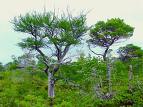Eastern White Pine Tree Information
Images of Eastern White Pine:






Eastern White Pine grows in the following 28 states and provinces:
Connecticut, Delaware, Georgia, Illinois, Indiana, Iowa, Kentucky, Maine, Manitoba, Maryland, Massachusetts, Michigan, Minnesota, New Hampshire, New Jersey, New York, North Carolina, Ohio, Ontario, Pennsylvania, Prince Edward Island, Rhode Island, South Carolina, Tennessee, Vermont, Virginia, West Virginia, WisconsinInformation about Eastern White Pine:
The Pinus Strobus is commonly known as the Eastern White Pine, Northern Pine, Northern White Pine, Pin Blanc, Soft Pine, Weymouth Pine as well as White Pine.
The currently accepted scientific name of eastern white pine is Pinus strobus L. . Little recognizes two varieties: the typical variety and Chiapas white pine (Pinus strobus var. chiapensis Mart.). Chiapas white pine, native to the mountains of southern Mexico and Guatemala, is also recognized as a separate species, Pinus chiapensis (Mart.) Andresen . This writeup discusses the typical variety, eastern white pine.Eastern white pine is distributed from Newfoundland west to extreme southeastern Manitoba and south to the Great Lake States, along the Atlantic seaboard to New Jersey, and in the Appalachian Mountains to northern Georgia. It also occurs in Iowa, western Kentucky, western Tennessee, and Delaware .Eastern white pine frequently dominates or codominates xeric northern pine forests . In mixed hardwood forests, it often occurs as a scattered dominant tree towering above the surrounding hardwoods . Publications listing eastern white pine as dominant or codominant are as follows: A multivariate analysis of forest communities in the western Great Smoky Mountains National Park The vegetation of Wisconsin The principal plant associations of the Saint Lawrence Valley Field guide: forest habitat types of northern Wisconsin Plant communities of Voyageurs National Park, Minnesota, U.S.A. A classification of the deciduous forest of eastern North America Virgin plant communities of the Boundary Waters Canoe Area Forest associations in the Harvard Forest Plant community pattern analysis: a cartographic approach applied in the Lac des Deux-Montagnes area (Quebec) Some of the information provided here is attributed to:Carey, Jennifer H. 1993. Pinus strobus. In: Fire Effects Information System, [Online]. U.S. Department of Agriculture, Forest Service, Rocky Mountain Research Station, Fire Sciences Laboratory (Producer). , available at the USDA Fire Effects Information System (FEIS) website